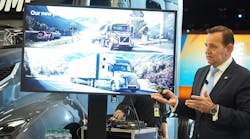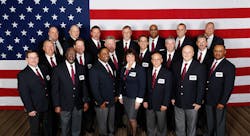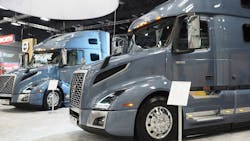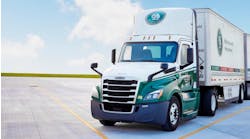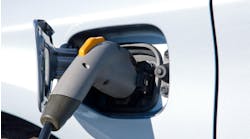AUSTIN, TX. Volvo Trucks North America's (VTNA) reboot of its product lineup has helped drive significant market share gains, the company said this week at the American Trucking Assns.' annual meeting. If you could snap your fingers and build every OEM's trucks on order, the North American market could even top half a million units, VTNA's new president said, though real-world constraints prevent that.
Peter Voorhoeve, who became president of VTNA in September, noted Volvo's truck offerings are doing well around the world. The company is a top-three player in the European market with 16% share, he said, also highlighting gains in Russia, South Africa, and Brazil, where total truck sales are rebounding after a large drop in recent years.
VTNA predicts the North American Class 8 market will be 300,000 units in 2018, climbing to 310,000 in 2019. This year, the OEM expects about 244,000 units for the U.S., 31,500 for Canada, and 24,500 for Mexico.
Within the market, Voorhoeve said the company has climbed from 8.6% share of U.S. Class 8 truck sales in 2017 to 10.5% so far in 2018. Mexico was the only area Volvo is down, with 2.0% of the market so far in 2018 vs. 2.3% last year. VTNA has seen pronounced growth in Canada, with the OEM claiming 13.9% share compared with 10.2% in 2017.
Typically in a mature market like Canada's, "if you do your best, you can maybe gain 1%, 1.5%, maximum 2% in a year's time," Voorhoeve said. "If all of a sudden you go almost 4% up, that is a truly massive performance and very good to see."
VTNA's sales in North America have been driven by its new VNL long-haul and VNR regional-haul trucks, both launched last year. Since the redesigns, VTNA has taken in more than 60,000 orders for those trucks from the start of sales Sept. 30, 2017 through the end of September this year.
In the third quarter of 2018 vs. the same quarter a year ago, Voorhoeve noted VTNA has taken in 215% more orders, so it's up by more than double.
"The limiting factors of the market are drivers and industry capacity," he contended. "All the truck manufacturers in North America cannot, mostly for the moment, build more than we are doing now. So that's a limiting factor."
"But if you look at the order boards for the industry, we could exceed 500,000," he added. "I don't think that's going to happen, quite frankly, but it shows that the market is very strong. The underlying economic performance in this country is also very strong.
"So it's a good time in the industry; it's exciting times."
Adjusting for a surging market—though analysts have suggested a likely back-swing of the pendulum and potential cool-off—VTNA has been addressing manufacturing capabilities.
"With the trend in this increasing market, we will continuously increase capacity," Voorhoeve said. "We have been investing heavily in our production setup in New River Valley, and the plans for this year, next year, and the year after are massive." The 1.6 million sq. ft. New River Valley assembly plant in Dublin, VA is the largest Volvo truck manufacturing facility in the world.
Since coming to the U.S. market in 1981, "I think we're now on a level where with our products and with substantial investments in our dealer network, we can truly say we're on par with everybody else in this industry," Voorhoeve said. "Volvo Trucks is a North American truck builder with a Swedish heritage and performance that exceeds many others."
Safety foundation
Meanwhile, with safety as a very well-known element of its lineup and Volvo vehicles generally, VTNA announced at the ATA conference it will continue to sponsor America's Road Team. VTNA donated one of its VNL 760s to the team earlier this year—it's used as a mobile classroom as the team's captains travel the country advocating for trucking and the vital role it plays in the economy and the importance of safe operation.
"I think you know we're known for safety," Voorhoeve said. "We don't do safety because it's fashionable; we don't do safety because all the newspapers are writing about it.
"We're doing safety because, since 1928 when we built our first truck and 1927 when we built our first car, our founder said that as long as there are people in and around our products, safety should be the primary design principle—the primary design principle," he emphasized.
He noted that Volvo Trucks is moving from reactive to proactive safety in its products and said full Volvo drivelines in its trucks work together as a whole to enhance safety performance. Like others, the OEM has focused on vertical integration.
On that note, VTNA is seeing a combined roughly 90% uptake on Volvo drivelines, with 92.4% of trucks built with the OEM's engines and 88.1% getting its I-Shift automated transmissions. "I-Shift increases safety because of the sheer fact that you can keep your eyes on the road," Voorhoeve said.
Reeling in the drivers
Voorhoeve also addressed that other constraint in the trucking industry he'd mentioned: availability of drivers. More advanced trucks not only can mean improved safety, according to Volvo's product design and strategy, but more comfortable operation of a more appealing vehicle.
VTNL believes that given its redesign efforts and sales uptick—"a growing market share in a growing market," he noted—it has effectively nailed it for North American, and particularly U.S., customers. And maybe that can help with that driver problem.
"We want to build trucks that are good for the drivers and that they like to drive—see if we can help make the profession more attractive," Voorhoeve said. Trucks like the VNL and VNR series offer "a far more technological environment," he added, that can help "spread the word that this is high-tech work."
"It's a very cool thing to drive," he added. "And we've gotten the feedback from our dealers and customers that if you ask them now, 'Do you build a truck that your customers want,' then the answer is 'yes' and the score is very high.
"So this is what American truck drivers like to drive."
